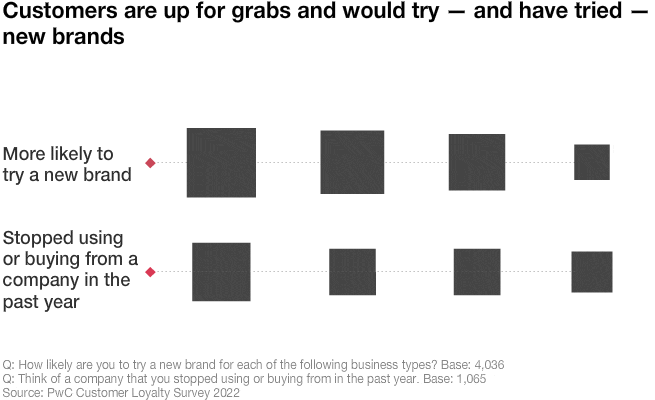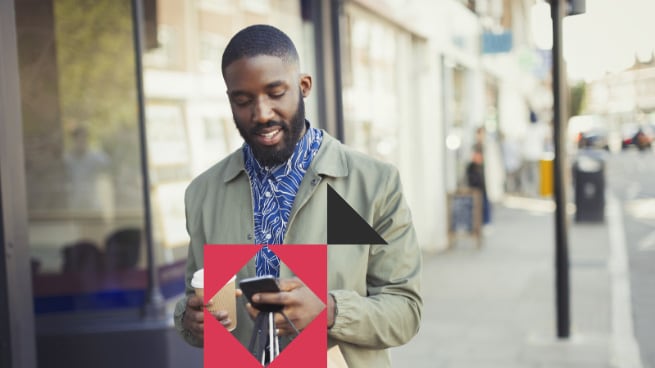{{item.title}}
{{item.text}}

{{item.text}}
PwC Customer Loyalty Survey 2022
Volatility in consumer behavior is at an all-time high. The COVID-19 pandemic fundamentally changed many needs and preferences. Inflation and a turbulent economy are influencing buying decisions. Technology creates unprecedented connectivity and access to goods and services. Consumers know more about where companies stand on environmental, social and governance (ESG) issues and expect businesses to share their beliefs. And let’s be honest: Consumers as a whole are more discerning than ever.
This all leaves companies wondering how they can better shape consumer demand and drive engagement with their brands. Unlocking what drives consumer loyalty has companies asking, “How do I attract and retain my customers?” Along with providing new insights from more than 4,000 consumers in the US, our PwC Customer Loyalty Survey 2022 reveals several opportunities for businesses to strengthen relationships, increase customer lifetime value and reduce the likelihood that they’ll leave.
More than one-fourth of survey respondents told us they stopped using or buying from a business in the past year, and bad experiences — with products or services and/or customer service — were the overwhelming reasons why.
As inflation persists, more than half of respondents said getting good value for the price of a product or service is a top reason why they keep using or buying from a business.
Personalization is a priority, too. Four out of five consumers would share some type of personal data for a better experience, with such information as email address, birthday and age, and sex/gender identity topping the list.
In an increasingly automated world, the human touch still matters. At least one-third of respondents said human interaction is important to their loyalty, and for many types of businesses it was more than 50%.
Ignore the digital dimension at your peril. More than half of respondents said they’re less likely to be loyal to a brand if its online shopping experience isn’t as easy or enjoyable as shopping in person.
As you might expect, generations differ significantly when it comes to loyalty. Generation Z (ages 18-25) and Millennials (26-41) are generally more mobile than Generation X (42-57) and Baby Boomers (58 and older), but they’re also more open to personalization and perks that can build loyalty.
The pandemic disrupted a wide range of industries and left businesses scrambling to adapt to shifting customer needs. Nearly three out of ten consumers in our survey say today they’re more likely to try a new brand, and younger generations are even more likely. Those percentages are higher for certain types of businesses, such as restaurants (44% more likely to try a new brand), consumer goods (38%) and supermarkets (36%).
Consumers are not only willing to walk away, they’re actually doing it: 26% of respondents said they stopped buying from a specific business in the past year. That percentage was higher — in some cases much higher — for many types of businesses, including airlines, restaurants, banks and hotels. And again, the younger the consumer, the greater chance he or she left a brand behind.
In addition to COVID-19, consumers are dealing with inflation. Among the many reasons why people regularly patronize a business, getting good value was the top reason at 53%. In addition, 30% said they like the benefits, rewards and privileges — discounts, rebates and special access or offers — they get with a preferred company’s loyalty program. By comparison, only 13% said they don’t consider price.
Among consumers whose loyalty has changed since before the pandemic, 15% say they’re now less loyal to brands they regularly bought from before COVID-19.
Bad experiences — even just one — can cost you customers. More than half (55%) of respondents said they would stop buying from a company that they otherwise liked after several bad experiences, and 8% said they would stop after just one bad experience. While 8% may not seem like much, it is when you're talking about a market-leading company with millions of customers. Are you willing to lose that many customers because of one bad experience? And it doesn’t just have to be “bad” experiences for some to leave: 32% said they’d drop a company if it provided inconsistent experiences.
And it isn’t just talk either. Among survey respondents who stopped using or buying from a specific business in the past year, a bad experience with products or services and a bad experience with customer service were top reasons. That indicates that service recovery is more important than ever for companies. In addition, younger generations were more likely than older generations to leave a brand because they liked the experience with another brand better.
What could improve those experiences and help retain customers? More humanity would help. In this automated age, consumers still want to talk to a real person. Respondents said human interaction is important or very important for their loyalty to restaurants (58%), financial services (55%), pharmacies (53%) and hotels (52%). In fact, for each type of business, at least one-third of respondents said human interaction is important. Companies also should determine how to balance investments in human interaction with offering an engaging digital experience. More than half (51%) of consumers said they’re less likely to be loyal to a brand if its online shopping experience isn't as easy or enjoyable as shopping in person. That number jumped to 69% for Generation Z and 57% for Millennials.
When it comes to the subscription services they use, 33% of consumers said they like discounts and rewards the most, 27% said subscriptions are less expensive than alternatives and 23% said they get faster and/or easier service.
More than half (55%) of consumers in our survey said they belong to at least one type of subscription service that allows them to make regular payments for access to a product or service. Benefits of subscriptions also factor in customer loyalty, as discounts, lower prices, faster and/or easier service and automatic renewals were what survey respondents liked most about the services. As expected, participation varies greatly by age: 81% of Generation Z members and 72% of Millennials said they have at least one subscription, compared to only 31% of Baby Boomers. Music, television and entertainment services are most popular overall, with 36% of respondents saying they subscribe. In addition, 17% said they subscribe to a bundled service that provides multiple services, and more than 10% have subscriptions for household goods, personal care items, food or alcohol, or clothing and fashion items.
Just as loyalty can hinge on a customer’s experience with a business, so can an experience be shaped by how personal it feels to a customer. When asked about getting a personalized experience from a business, 87% of survey respondents named at least one part of that experience that’s most important to them.
In addition, 82% are willing to share some type of personal data for more personalized service. Comfort levels were strongest with personal identifiers, with 48% willing to share their birthday and age, 45% their sex/gender identity and 37% their race/ethnicity. Many consumers also are OK with contact information such as an email address (61%), mailing address (40%) and phone number (35%). Specifics about usage and biometrics are a harder sell. Only 22% said they’re willing to share product usage data, 15% their current location (via mobile phone), 5% facial recognition and 3% a fingerprint.
Consumers also prize flexibility in personalization, with one of the top preferences being “rewards my way” in a loyalty program. That priority offers businesses an opportunity to experiment more with experiential loyalty to improve customer retention. Among age groups, Generation Z is more likely than older generations to want easy or fast access to products or services, brands to remember their preferences and to be able to seamlessly switch between mobile, online and in-store experiences.
Between longer lifespans and people interacting with brands at younger ages, businesses have more opportunities to connect with consumers and win their loyalty. Our survey found that Millennials and Generation Z show loyalty in more ways than Generation X and especially Baby Boomers.
While getting good value for price and the quality/consistency of products or services are top reasons why younger people keep using a business, those consumers overall don’t feel as strongly as older ones about those factors. By comparison, more Millennials and members of Generation Z value fast service, feeling like they’re part of a community and having a personalized experience. To that end, more Generation Z members (41%) and Millennials (37%) were willing to share their personal interests, preferences or habits with a business to get a more personalized experience.
Generations also differed in why they stopped buying from a business in the past year. Generation Z and Millennials were more likely to cite more than one reason for leaving compared to older generations. But larger percentages of Generation X and Baby Boomers said they left a brand to support or boycott issues they feel are important in society, such as the environment, diversity and charitable giving.
69% of co-branded credit cardholders say they likely would buy from the brand that issued the card.
As companies explore other ways to earn loyalty and consumers seek more benefits, co-branded credit cards — offered by businesses in partnership with a bank or credit card company with rewards such as airline miles and fuel points — have grown in popularity. Three out of five survey respondents have some type of co-branded credit card, with higher percentages of men than women and older consumers than younger ones being cardholders. More than two-thirds of cardholders said they’d likely buy from the brand that issued the card, including more than a third who said very likely. But almost one-fourth said the card doesn’t drive more loyalty — they’re neither likely nor unlikely to buy from the brand on the card. Also, similar to the overall shift in customer loyalty during the pandemic, 30% of co-branded cardholders said the benefits or rewards were more valuable now than before COVID-19, while only 10% said less.
The challenges of winning and keeping a consumer’s business are very real, but so are the opportunities for businesses in many industries. Here are some ways you can better connect with your customers and increase the odds of earning their loyalty.
PwC surveyed 4,036 consumers in the US between May 5 and May 19, 2022. Respondents in the online survey were adults 18 and older, with demographic weighting to achieve census representation on age, gender, race, US region, income, employment status and marital status.
{{item.text}}

{{item.text}}









